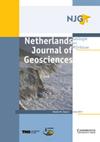Geology of the Upper Jurassic to Lower Cretaceous geothermal aquifers in the West Netherlands Basin – an overview
IF 2.3
2区 地球科学
Q3 GEOSCIENCES, MULTIDISCIPLINARY
Netherlands Journal of Geosciences-Geologie En Mijnbouw
Pub Date : 2020-03-19
DOI:10.1017/njg.2020.1
引用次数: 5
Abstract
Abstract In the past 10 years the mature hydrocarbon province the West Netherlands Basin has hosted rapidly expanding geothermal development. Upper Jurassic to Lower Cretaceous strata from which gas and oil had been produced since the 1950s became targets for geothermal exploitation. The extensive publicly available subsurface data including seismic surveys, several cores and logs from hundreds of hydrocarbon wells, combined with understanding of the geology after decades of hydrocarbon exploitation, facilitated the offtake of geothermal exploitation. Whilst the first geothermal projects proved the suitability of the permeable Upper Jurassic to Lower Cretaceous sandstones for geothermal heat production, they also made clear that much detail of the aquifer geology is not yet fully understood. The aquifer architecture varies significantly across the basin because of the syn-tectonic sedimentation. The graben fault blocks that contain the geothermal targets experienced a different tectonic history compared to the horst and pop-up structures that host the hydrocarbon fields from which most subsurface data are derived. Accurate prediction of the continuity and thickness of aquifers is a prerequisite for efficient geothermal well deployment that aims at increasing heat recovery while avoiding the risk of early cold-water breakthrough. The potential recoverable heat and the current challenges to enhance further expansion of heat exploitation from this basin are evident. This paper presents an overview of the current understanding and uncertainties of the aquifer geology of the Upper Jurassic to Lower Cretaceous strata and discusses new sequence-stratigraphic updates of the regional sedimentary aquifer architecture.西荷兰盆地上侏罗统至下白垩统地热含水层的地质概况
在过去的10年里,西荷兰盆地的成熟油气省地热开发迅速扩大。上侏罗统至下白垩统地层自20世纪50年代以来已形成油气,成为地热开发的目标。大量公开的地下数据,包括地震调查、数百口油气井的几口岩心和测井数据,再加上数十年油气开采后对地质的了解,促进了地热开采的开展。虽然第一个地热项目证明了上侏罗世到下白垩世渗透性砂岩适合地热生产,但他们也清楚地表明,含水层地质的许多细节尚未完全了解。由于同构造沉积作用,整个盆地的含水层构型变化显著。包含地热目标的地堑断块经历了不同的构造历史,而大多数地下数据都来自于拥有油气田的宿主和弹出构造。准确预测含水层的连续性和厚度是有效部署地热井的先决条件,旨在提高热采收率,同时避免早期冷水突破的风险。该盆地的潜在可采热量和当前面临的挑战是显而易见的。本文综述了目前对上侏罗统至下白垩统地层含水层地质的认识和不确定性,并讨论了区域沉积含水层结构的新的层序地层更新。
本文章由计算机程序翻译,如有差异,请以英文原文为准。
求助全文
约1分钟内获得全文
求助全文
来源期刊
CiteScore
4.00
自引率
25.90%
发文量
14
审稿时长
>12 weeks
期刊介绍:
Netherlands Journal of Geosciences - Geologie en Mijnbouw is a fully open access journal which publishes papers on all aspects of geoscience, providing they are of international interest and quality. As the official publication of the ''Netherlands Journal of Geosciences'' Foundation the journal publishes new and significant research in geosciences with a regional focus on the Netherlands, the North Sea region and relevant adjacent areas. A wide range of topics within the geosciences are covered in the journal, including "geology, physical geography, geophyics, (geo-)archeology, paleontology, hydro(geo)logy, hydrocarbon exploration, modelling and visualisation."
The journal is a continuation of Geologie and Mijnbouw (published by the Royal Geological and Mining Society of the Netherlands, KNGMG) and Mededelingen Nederlands Instituut voor Toegepaste Geowetenschappen (published by TNO Geological Survey of the Netherlands). The journal is published in full colour.

 求助内容:
求助内容: 应助结果提醒方式:
应助结果提醒方式:


